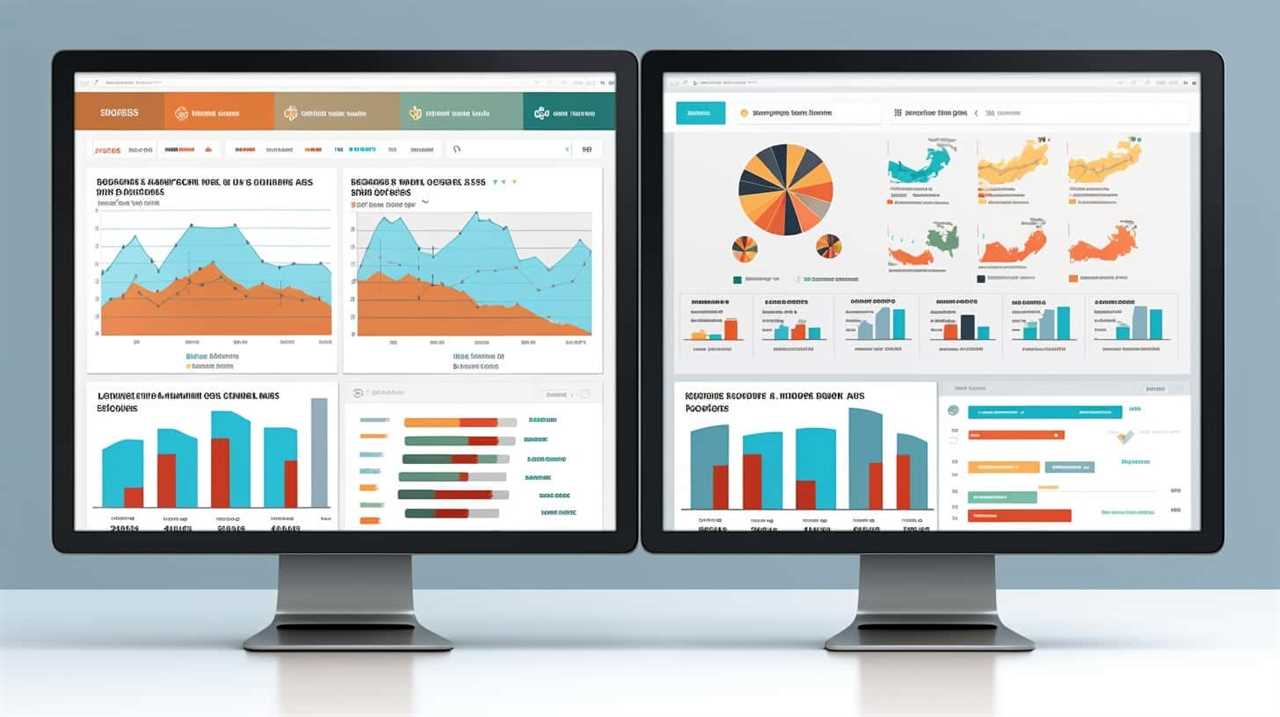Looking to excel in local SEO? Look no further! Below are the top 7 crucial services you need for on-page dominance.
From keyword research to user experience and navigation, we’ve got you covered. Our team is here to optimize your website’s speed, performance, and mobile compatibility.
With our content creation and optimization strategies, along with local citations and directory listings, you’ll dominate the local search rankings.
Get ready for mastery in local SEO!

Key Takeaways
- Thorough keyword research and analysis are essential for identifying relevant and high-performing keywords for local SEO campaigns.
- Implement effective on-page optimization strategies, such as optimizing meta tags, headings, content, and URLs, to improve website visibility and user experience.
- Establish strong local citations and directory listings by mentioning business name, address, and phone number (NAP) on other websites and online directories.
- Improve website speed and performance, optimize for mobile devices, and create and optimize SEO-friendly content to enhance local SEO efforts.
Keyword Research
We conduct thorough keyword research to identify the most relevant and high-performing keywords for our local SEO campaigns.
This process involves analyzing our competitors to understand the keywords they’re targeting and the strategies they’re using. By conducting competitor analysis, we gain valuable insights into the keywords that are driving traffic and conversions for our competitors.
We also focus on long tail keywords, which are longer and more specific phrases that have less competition. These keywords enable us to target a niche audience and increase our chances of ranking higher in search engine results.
On-Page Optimization
To ensure on-page excellence, it is crucial to implement effective on-page optimization strategies. On-page optimization plays a vital role in improving website visibility, user experience, and ultimately, on-page rankings. By optimizing various elements on a webpage, such as meta tags, headings, content, and URLs, you can make your website more search engine friendly and increase its chances of ranking higher in search engine result pages (SERPs).

Here is a table that outlines some key on-page optimization strategies:
| On-Page Optimization Strategies | Description |
|---|---|
| Keyword Optimization | Incorporating relevant keywords naturally throughout the content. |
| Title Tag Optimization | Creating concise and keyword-rich title tags for each webpage. |
| URL Optimization | Including targeted keywords in the URL structure. |
| Image Optimization | Optimizing image filenames, alt tags, and sizes. |
| Content Optimization | Creating high-quality, informative, and engaging content. |
Local Citations and Directory Listings
For effective local SEO, it’s essential to establish strong local citations and directory listings.
Local citations refer to online mentions of your business’s name, address, and phone number (NAP) on other websites. These citations can help improve your online visibility and credibility, as search engines use them to validate your business’s existence and location.
Directory listings, on the other hand, are online directories where you can list your business’s information. These listings not only provide another avenue for potential customers to find your business but also contribute to your online reputation management.

By ensuring that your business is accurately listed in local directories, you can boost your visibility and credibility in the eyes of both search engines and consumers.
Now, let’s move on to the next section, where we’ll discuss the importance of website speed and performance.
Website Speed and Performance
Improving website speed and performance is crucial for optimizing local SEO and enhancing the user experience. When it comes to website speed and performance, there are several key factors to consider:
- Website caching: Implementing website caching can significantly improve page load times by storing static versions of your website’s pages. This reduces the server load and enhances the overall user experience.
- Image optimization: Optimizing images by reducing their size without compromising quality can greatly improve website speed. Compressing images, using the appropriate file format, and leveraging lazy loading techniques are some effective ways to optimize images.
- Minifying code: Minifying code involves removing unnecessary characters, whitespace, and comments from your website’s code. This helps reduce file sizes and improves load times.
Mobile Optimization
When it comes to local SEO, mobile optimization is crucial for success. With the increasing number of users accessing websites through their mobile devices, having a responsive design is of utmost importance.

Not only does it ensure that your website looks great on all screen sizes, but it also improves the overall mobile user experience, leading to higher engagement and conversions.
Responsive Design Importance
With the increasing prevalence of mobile devices, optimizing your website for mobile users is essential to ensuring a seamless browsing experience. In today’s digital landscape, a user-friendly design and a responsive website are more important than ever. Here are three key reasons why responsive design is crucial for your website:
- Improved user experience: A responsive design allows your website to adapt to different screen sizes, ensuring that it looks and functions well on any device. This enhances the user experience and keeps visitors engaged.
- Higher search engine rankings: Search engines prioritize mobile-friendly websites in their rankings. By having a responsive design, you can improve your website’s visibility and attract more organic traffic.
- Increased conversion rates: Responsive websites are easier to navigate and interact with, which leads to higher conversion rates. When users can easily access and use your website on their mobile devices, they’re more likely to take the desired action.
Ensuring a responsive design for your website is just the first step in providing an optimal mobile user experience. Now let’s delve into the importance of mobile user experience and how it impacts your local SEO efforts.
Mobile User Experience
Now that we’ve established the importance of responsive design for your website, let’s explore how mobile user experience, also known as mobile optimization, plays a crucial role in your local SEO efforts.

With the increase in mobile search and the growing number of users accessing websites on their smartphones and tablets, it’s essential to ensure that your website is optimized for mobile devices. Mobile optimization involves improving the functionality and usability of your website on smaller screens, providing a seamless experience for users.
A well-optimized mobile website not only improves user engagement but also helps in improving your local SEO rankings. By providing a positive user experience on mobile devices, you’re more likely to attract and retain visitors, increasing the chances of them engaging with your content and ultimately converting into customers.
Now, let’s move on to the next section about content creation and optimization.
Content Creation and Optimization
When it comes to content creation and optimization for local SEO, there are a few key points to keep in mind.

First, conducting thorough keyword research is crucial in order to identify the most relevant and valuable keywords for your target audience.
Second, writing SEO-friendly content that incorporates these keywords naturally can help improve your website’s visibility in search engine results.
Lastly, optimizing meta tags, such as title tags and meta descriptions, can further enhance your website’s search engine optimization.
Keyword Research Techniques
For successful content creation and optimization, we rely on effective keyword research techniques. Conducting competitor analysis allows us to identify the keywords our competitors are targeting and gain insights into their strategies. This helps us stay ahead of the competition and optimize our content accordingly.

Long tail keywords, on the other hand, play a crucial role in driving targeted traffic to our website. These keywords are more specific and have lower search volume, but they often have higher conversion rates. By incorporating long tail keywords into our content, we can attract users who are actively searching for the products or services we offer.
With a combination of competitor analysis and long tail keywords, we can create and optimize content that ranks higher in search engine results and drives quality traffic to our website.
Seo-Friendly Content Writing
To optimize our website’s local SEO, we rely on SEO-friendly content writing. This involves creating and optimizing content that drives quality traffic and improves our search engine rankings.
An effective SEO content strategy is crucial for attracting and engaging our target audience. We focus on understanding our audience’s needs, conducting thorough keyword research, and incorporating relevant keywords into our content.

SEO copywriting techniques, such as using compelling headlines, incorporating keywords naturally, and structuring our content for readability, are essential for optimizing our content for search engines.
We also prioritize providing valuable and informative content that answers our audience’s questions and solves their problems.
Optimizing Meta Tags
As we delve into the topic of optimizing meta tags for content creation and optimization, we continue our focus on driving quality traffic and improving search engine rankings through SEO-friendly content writing.
Meta tag optimization plays a crucial role in attracting users and search engine crawlers to your website. Here are three key points to consider:

- Meta descriptions: Crafting compelling and concise meta descriptions is essential for enticing users to click on your website in search results.
- Title tags: Including relevant keywords in your title tags helps search engines understand the topic of your page, increasing its visibility.
- Meta keywords: While the impact of meta keywords on search rankings has diminished, it’s still important to include relevant keywords to provide further context to search engines.
By optimizing these meta tags, you can boost your website’s visibility in search results and drive more targeted traffic.
Now, let’s move on to discussing the importance of user experience and navigation.
User Experience and Navigation
Improving user experience and navigation is crucial for achieving on-page excellence in local SEO. User engagement and website layout play a significant role in how visitors interact with your site and ultimately determine whether they stay or leave.
To enhance user experience, focus on creating a visually appealing and easy-to-navigate website layout. Ensure that your website is mobile-friendly, as more and more people are using their smartphones to browse the internet.

Implement clear and intuitive navigation menus, making it effortless for users to find the information they’re looking for. Additionally, optimize page load times to minimize frustration and maximize user satisfaction.
Frequently Asked Questions
How Can I Optimize My Website for Local SEO Without Conducting Keyword Research?
We can optimize our website for local SEO without conducting keyword research by using alternative methods such as focusing on user reviews, which can have a significant impact on local SEO rankings.
What Are Some Common Mistakes to Avoid When Optimizing On-Page Content for Local Seo?
When optimizing on-page content for local SEO, it’s important to avoid common mistakes. We should focus on following best practices for on page optimization and creating high-quality on page content.
Are Local Citations and Directory Listings Still Important for Local SEO in 2021?
Local citations and directory listings are still important for local SEO in 2021. They help improve online visibility, establish credibility, and boost rankings. Incorporating online reviews and implementing effective strategies for local link building are essential for success.

How Can I Improve the Speed and Performance of My Website for Better Local SEO Rankings?
Improving website speed for better local SEO rankings is crucial. We’ve found effective ways to boost website performance for local SEO, such as optimizing images, minifying CSS and JavaScript, and leveraging caching techniques.
Is Mobile Optimization Necessary for Local SEO, or Can I Focus Solely on Desktop Users?
We cannot ignore the significance of mobile optimization in local SEO. Focusing solely on desktop users would limit our reach. Responsive web design benefits both mobile and desktop user experiences, improving our rankings overall.
Conclusion
In conclusion, local SEO plays a crucial role in enhancing online visibility and attracting local customers. By utilizing top-notch services such as keyword research, on-page optimization, and local citations, businesses can ensure their websites are optimized for search engines and provide an excellent user experience.
With the right strategies, businesses can skyrocket their online presence and dominate the local market. It’s like unleashing a tidal wave of success that sweeps away the competition.









